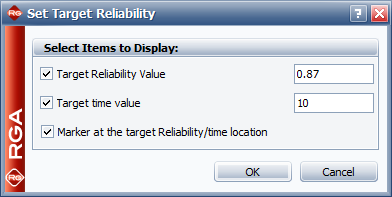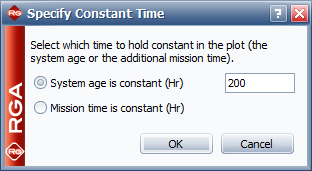

| Related Topics: | ||
The control panel includes the following options:
The Plot Type drop-down list provides a choice of applicable plots. To learn more about the selected plot, click the blue (i) icon. This area also contains an indicator light that displays the status of the plot sheet in relation to the analysis it is associated with. If the light is green, then the plot reflects the current analysis. If the light is red, then you will have to update the plot by refreshing it and/or reanalyzing the associated data sheet. For more information about the available plot types, refer to the specific topic covering the analysis type.

The Units drop-down list allows you to choose which units you want the plot to show.
Auto Refresh automatically updates the plot to reflect any changes that have been made. If not selected, you must click the Redraw Plot icon to refresh the display.
Keep Aspect Ratio maintains the ratio of the horizontal size to the vertical size of the plot graphic when you resize the plot sheet.
Horizontal Bars (available for Individual Mode MTBF, Individual Mode FI, Final MTBF, Final FI plots) displays the plot using horizontal, not vertical bars.
Use Logarithmic Axes (available for Cumulative Number of Failures, Cumulative Number of BD Modes, MTBF BD Unseen and Discovery Rate plots) plots the function on a log-log paper.
Target MTBF/FI (available for Growth Potential MTBF, Growth Potential FI and MTBF vs. Time plots), opens the Set Target window, as shown below for the Growth Potential MTBF plot. This window allows you to specify whether and how the target MTBF or Failure intensity will be shown on the plot.

Target [MTBF/FI] Value allows you to enter a target value. If the check box is selected, this value will be displayed on the plot as a horizontal line.
Target time value allows you to enter a time value for the target point. If the check box is selected, this value will be displayed on the plot as a vertical line.
Marker at the target [MTBF/FI]/time location allows you to circle the target point on the plot (i.e., the intersection of the target value and the target time value).
Target Reliability (available for Reliability vs. Time and Unreliability vs. Time plots), opens the Set Target window, as shown below for the Reliability vs. Time plot. This window allows you to specify whether and how the target reliability or unreliability will be shown on the plot.

Target Reliability value allows you to enter a target value. If the check box is selected, this value will be displayed on the plot as a horizontal line.
Target time value allows you to enter a time value for the target point. If the check box is selected, this value will be displayed on the plot as a vertical line.
Marker at the target [Reliability/Unreliability]/time location allows you to circle the target point on the plot (i.e., the intersection of the target value and the target time value).
In the Scaling area, the X and Y Scaling boxes show the minimum and maximum values for the x- and y-axes. You can change these values if the check box beside the value range is not selected. If it is selected, the application will automatically choose appropriate values for the range.
Mission time is constant/System age is constant (available for Conditional Reliability/Unreliability plots) allows you to specify whether the mission time will be held constant while the system age (time/ stage) is varied or vice versa. Clicking the ... button will open the Select Constant Time window, as shown next.

Results displays calculated parameters and other results in the Results window. This is identical to the main Results area on the standard folio control panel.
Associated Data Sheet displays the data sheet that the plot is based on. Clicking this link opens the data sheet.
The folio tools are arranged on the left side of the control panel:
![]() Redraw
Plot updates the plot to reflect any changes that have been made.
Redraw
Plot updates the plot to reflect any changes that have been made.
![]() Plot Setup opens the
Plot Setup window, which allows you to customize
most aspects of the plot including the titles, colors, sizes, etc.
Plot Setup opens the
Plot Setup window, which allows you to customize
most aspects of the plot including the titles, colors, sizes, etc.
![]() RS Draw launches ReliaSoft Draw, which allows you to
view the plot in greater detail, add annotations and modify selected plot
elements.
RS Draw launches ReliaSoft Draw, which allows you to
view the plot in greater detail, add annotations and modify selected plot
elements.
![]() Side-by-Side Plots adds a side-by-side plot to the project, which allows you to view different plots at the same time in a single window. If no side-by-side plots exist in the project, selecting this option creates one. Otherwise, a window will appear which allows you to select an existing side-by-side plot to associate the data sheet with or to create a new one.
Side-by-Side Plots adds a side-by-side plot to the project, which allows you to view different plots at the same time in a single window. If no side-by-side plots exist in the project, selecting this option creates one. Otherwise, a window will appear which allows you to select an existing side-by-side plot to associate the data sheet with or to create a new one.
![]() QCP opens the Quick Calculation Pad (QCP), which allows you to calculate results based on the analyzed data sheet.
QCP opens the Quick Calculation Pad (QCP), which allows you to calculate results based on the analyzed data sheet.
The types of plots that are available depend on the model used for analysis and/or the data type. For more information, refer to the Quick Calculation Pad (QCP) topic.
© 1992-2015. ReliaSoft Corporation. ALL RIGHTS RESERVED.